Slow Cognition: Mapping Thematic Journey (Engaging with Activity Theory, 2020 - 2022)

The Journey of Engaging with Activity Theory
On Sept 5, 2022, I published Slow Cognition: Mapping Thematic Landscape (Curativity, 2019 - 2022) and introduced a new tool called Thematic Landscape Map and used it to explore my "Curativity" knowledge enterprise.
The past weekend, I worked on a similar task and developed a new method called Mapping Thematic Journey. I used my journey of "Engaging with Activity Theory" to develop the method and related tools.
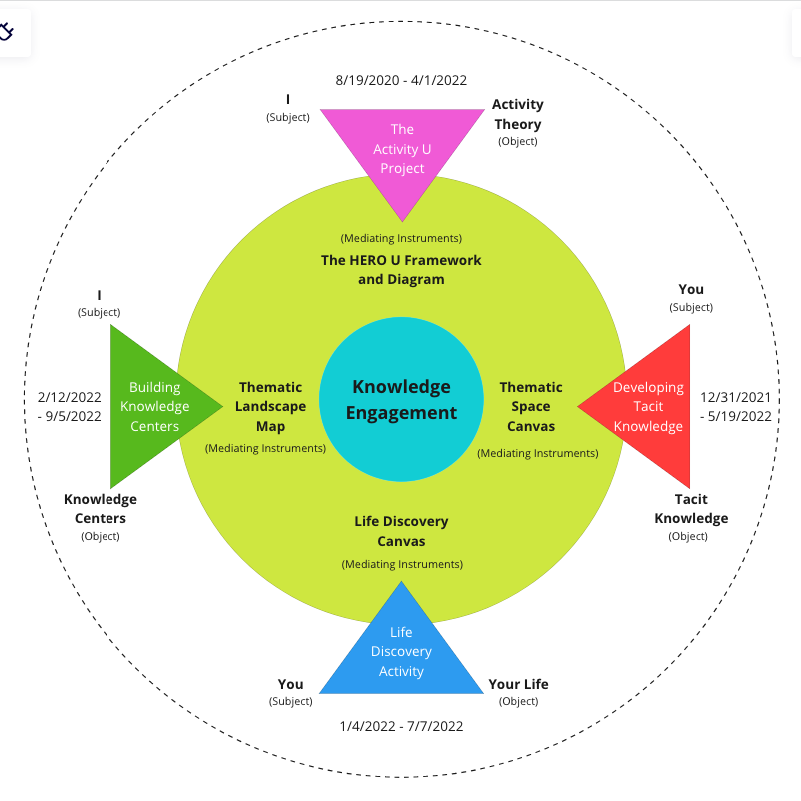
Mapping Thematic Journey uses a set of diagrams for visualizing a multi-project thematic journey. The above one is the main diagram which displays four projects in nested three circles.
Contents
1. A Journey of Knowledge Engagement
2. A Possible Journey with Four Projects
3. The Basic Model of Thematic Journey Map
4. Mapping Developmental Projects
5. Operational Concepts and Theoretical Concepts
6. The Developmental Project Model
7. Product, By-product, and Meta-product
8. Results, Rewards, and Contributions
9. Modeling A Project
10. Developing A Concept
11. Developing A Service
12. An Expansive Model
13. Knowledge Engagement: The Objectification of Concepts
14. Conclusion
(9,101 words)
1. A Journey of Knowledge Engagement
Last week I reflected on my work on Activity Theory. I used the "Diagramming as Thinking" method to conduct a tiny Life Discovery project.
In the past three years, I run several projects about Activity Theory. I selected four and considered them as a journey.
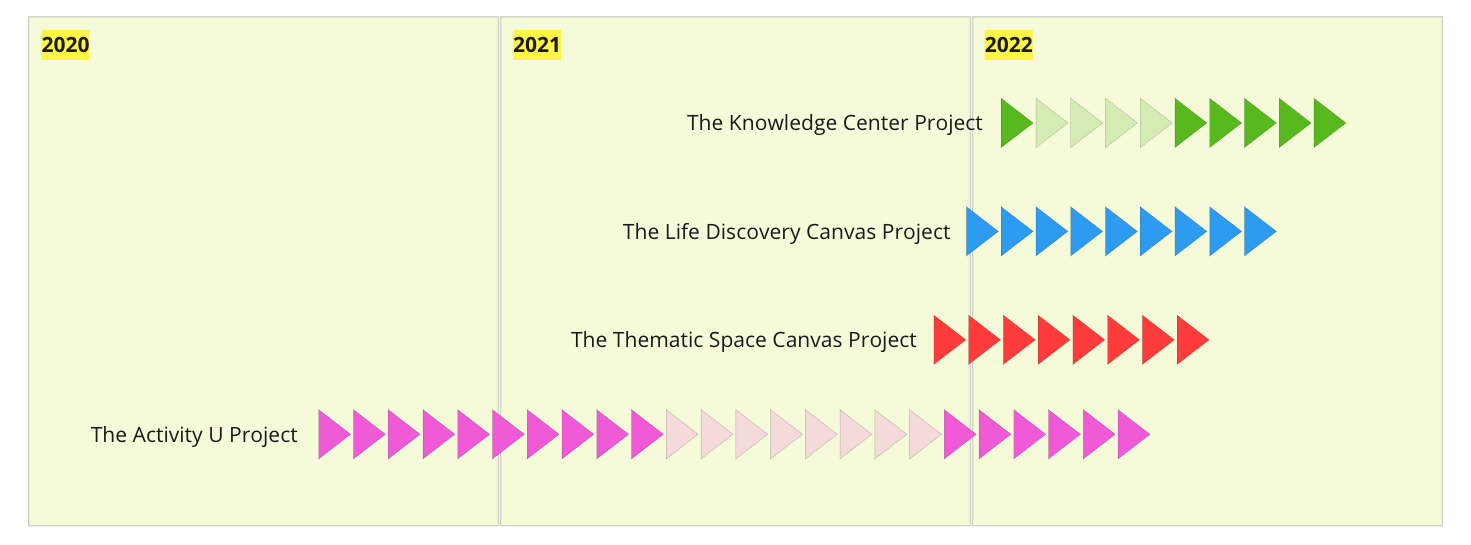
While designing the above diagrams, I also looked back at where the journey began. I often used "Knowledge Curation" to describe my work on Activity Theory. You can find more details in Activity U — A Knowledge Curation Project.
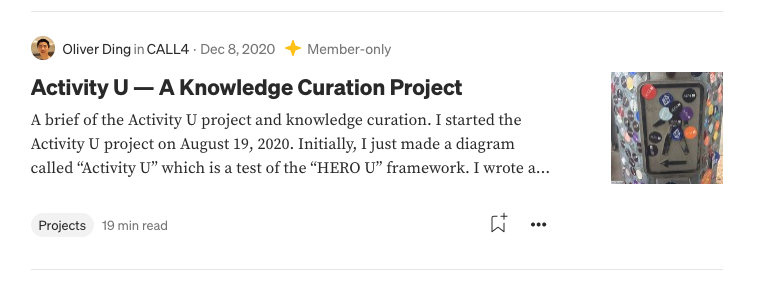
However, I realized that it is only suitable for the Activity U project. The other projects are not "Knowledge Curation".
The "Thematic Space Canvas" project and the "Life Discovery Canvas" project are about making for knowing while Using Activity Theory.
The "Building Knowledge Centers" project considers "Activity Analysis Center" as the first prototype of the concept of "Knowledge Center". Activity Analysis Center aims to connect Activity Theory and Practitioners.
Thus, I decided to use "Knowledge Engagement" as the primary theme of this journey.
The term "Knowledge Engagement" is inspired by the Project Engagement approach (v2.1). If you work on a knowledge-related project, you can use the term to describe your project.
The Project Engagement Approach (v2.1) was introduced on August 2, 2022. Now I am moving from theoretical development to practical applications.
The Project Engagement approach follows Andy Blunden’s approach to an interdisciplinary theory of activity. His version considers “Activity as Formation of Concepts” and this process is a “Project”. I wrote a book titled Project-oriented Activity Theory in 2020/2021. The second part of the book is named Project Engagement. I used it to refer to several modules I developed for applying Andy Blunden’s approach to the practical level.
I also developed a concept called “Themes of Practice” for my own approach called the Ecological Practice approach before 2020. Later, I found Andy Blunden’s notion of “Activity as Formation of Concepts” echoes “Themes of Practice”.

The Project Engagement approach (v2.1) also has the following slogan:
Life = Projects = Thematic Spaces = Events = History
Eventually, I developed a series of tools and methods for qualitative data analysis.
I also slowly moved to real applications of the Project Engagement approach in August 2022.
I selected Knowledge Creators as the target audience because my approach considers “Activity=Concept/Theme=Project”. Since Knowledge Creators’ products are Knowledge that can be understood as themes and concepts, it is perfect to apply the approach to research Knowledge Creators’ creative work and life.
2. A Possible Journey with Four Projects
Life is a meaningful journey. Moreover, there is a deep idea behind the metaphor: Life is about Spatial Difference.
This view is inspired by George Lakoff and Mark Johnson’s ideas on the Cognitive Science of the Embodied Mind in their 1999 book Philosophy in The Flesh and other books. According to Lakoff and Johnson, “Very little of our understanding of time is purely temporal. Most of our understanding of time is a metaphorical version of our understanding of motion in space.” They introduce a metaphor system of time in the book, see the note below:

In the 2000 book Where Mathematics Comes From, George Lakoff and Rafael E. Nunez use the Source-Path-Goal schema as an example of the cognitive science of the embodied mind. See the picture below:

The Source-Path-Goal schema points out that there is an unrealized trajectory between the location of the trajector at a given time (present) and the goal (future). The diagram clearly shows the Temporal Difference between Present and Future is the Spatial Difference between the present location and future goal.
From the perspective of Cognitive Metaphor theory, the metaphor behind the journey is the Event-Structure metaphor. According to George Lakoff and Mark Johnson, Journeys are long-term activities:
A journey takes an extended period of time, covers a lot of ground, and usually involves stopping at a number of destinations along the way before one reaches a final destination, if there is one.
Given the rest of the Event — Structure metaphor, journeys correspond to long-term activities, usually with a number of intermediate purposes. The intermediate purposes are intermediate destinations, the ultimate purpose is the ultimate destination, the actions performed are movements, progress is movement toward a destination, the initial state is the initial location, and achieving the purpose is reaching the ultimate destination.
Every aspect of the source domain of the Event — Structure metaphor may occur in some kind of journey, and hence journeys are very useful for talking about long-term activities of many kinds. (Philosophy in the Flesh, 1999, pp.193–194)
If we put the Source-Path-Goal schema and the Event-Structure metaphor together, we can use them to understand the two levels of "Journey".
- Journey: the Event-Structure metaphor, long-term activities, and a number of intermediate purposes.
- Project: the Source-Path-Goal schema, short-term projects, each project refers to an intermediate purpose of the Journey.
However, there is a reality in my life. I didn't plan the above four projects in the beginning. The "Thematic Space Canvas" project was not designed in 2020. The "Life Discovery Canvas" project was born from the "Themtaic Space Canvas" project.
I planned something about Phase II of the Activity U project on Dec 8, 2020. However, the plan didn't want to run a project as a prototype of the "Building Knowledge Centers" project. The concept of "Knowledge Center" was born in Feb 2022.
How can I claim that these four projects are a meaningful whole?
In Life Strategy: The “Possible Journey”, I introduced a technique called "Possible Journey" for designing a Developmental Project.
There are several related terms to the technique:
- Real Events
- Actual Journeys
- Possible Journeys
- Imagined Journeys
Real Events refer to things that happen in our life while Actual Journeys refer to planned activities that contain several actions as real events.
The above four projects are Real Events because they happened in my life. However, they are not an Actual Journey because they are not planned as a meaningful whole in the beginning.
Thus, they are a Possible Journey.
Since the meaning of an Actual Journey is given in the beginning, what is the meaning of a Possible Journey as a whole?
A possible journey needs a reasonable structure to curate several intermediate purposes into a new meaningful whole.
This is a challenge of sensemaking with life projects.
I needed to discover the meaning behind the above four projects as a whole.
This is the reason that I developed the Thematic Journey Map and the method of Mapping Thematic Journey.
I hope this tool is useful for discovering a shared theme behind life projects and a reasonable structure behind a possible journey.
Moreover, I expect that the tool could lead to a transformation from a Possible Journey to an Imagined Journey. For example, if we add an imagined fifth project to the Possible Journey, it becomes an Imagined Journey.
In this way, Mapping Thematic Journey is about both reflecting on the Past and anticipating the Future.
3. The Basic Model of Thematic Journey Map
The main diagram of Thematic Journey Map is based on the following basic model.
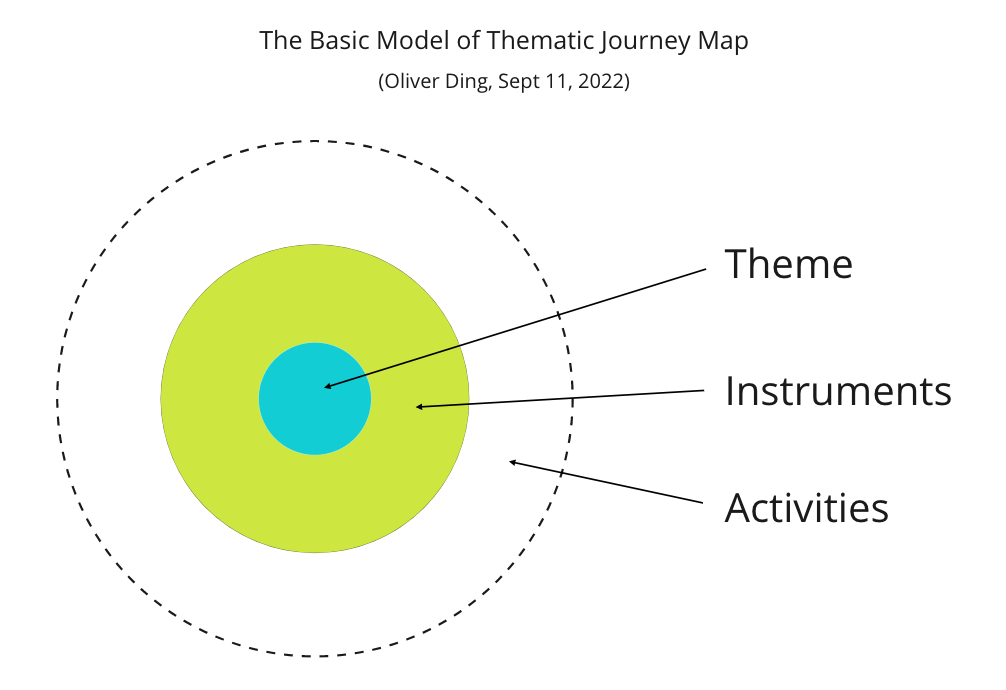
This three-level schema is similar to the basic model of the Thematic Landscape Map which uses "Play[Work(Theme)] " as the basic structure.

The Thematic Landscape Map uses three nested circles as a basic model.
- Theme: this inner circle is for displaying Themes and Books.
- Work: the middle circle refers to Projects and two types of Knowledge Frameworks: Abstract Models and Concrete Models.
- Play: the outer circle is about Programs that consider two types of things: Tools and Actions.
While the Theme circle and the Work circle are about knowledge makers' individual work, the Play circle refers to the collaborative space between knowledge makers and knowledge users.
These three circles also have different significant aspects of complexity.
- Theme: the cognitive aspect of complexity is the primary challenge.
- Work: the material aspect of complexity is the primary challenge.
- Play: the social aspect of complexity is the primary challenge.
We can roughly consider Thematic Journey Map as a simple version of Thematic Landscape Map. However, there is a difference between these two.
For Thematic Landscape Map, I want to explore the Complexity of the Network of Knowledge Centers which is located at the "Work" level. The Inner Circle (the "Theme" level) refers to a web of themes that is about the development of an individual mind while the Outer Circle (the "Play" level) refers to a network of social practices such as knowledge services.
My purpose behind the method of Mapping Thematic Journey is different from Mapping Thematic Landscape. I want to understand a set of knowledge projects in a meaningful whole. The primary focus is not on Knowledge Centers, but on a person's Creative Work. So I use the "Journey" metaphor to refer to the whole.
The "Journey" metaphor also emphasizes the historical development of my knowledge projects.
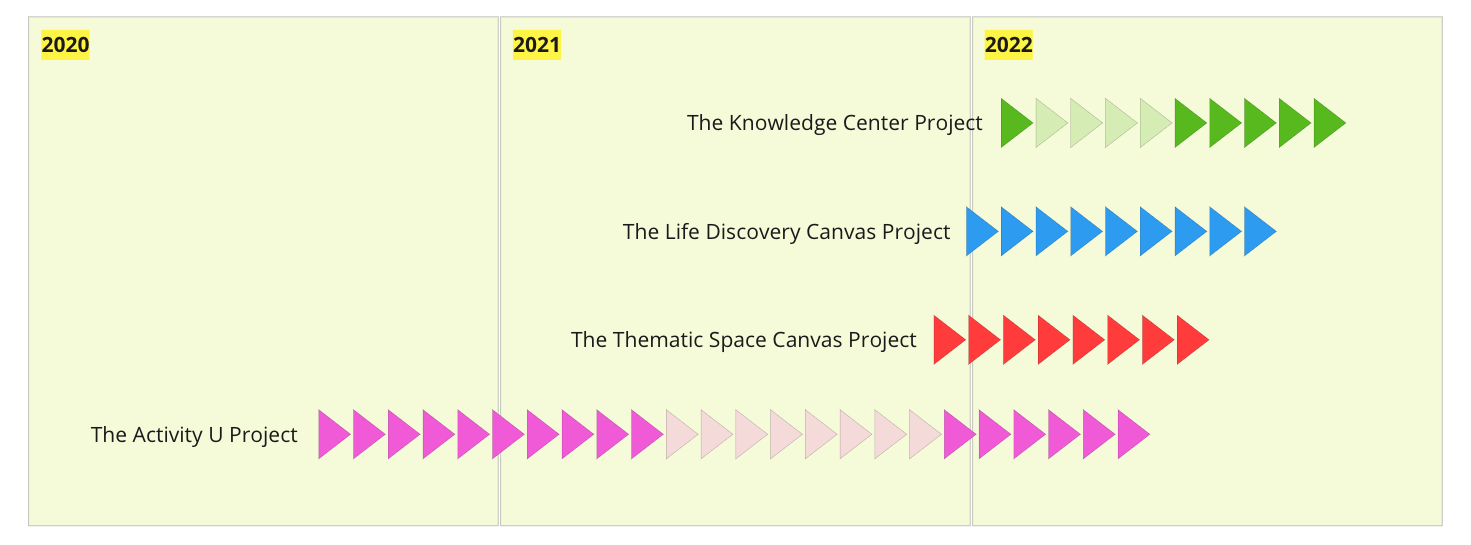
What does the triangle mean?
It refers to the basic model of Activity Theory: Subject - Mediating Instruments - Object and the concept of Mediation.

The concept of Mediation is important for Activity Theory. Since the theoretical traditions have different versions, the concept of Mediation also has different versions. You can find more details in The Concept of Mediation [Activity Theory].
The foundation of Activity Theory and CHAT, in general, is Lev Vygotsky’s idea of “mediated action”. Vygotsky claimed that human action and psychological functions are mediated by tools which refer to technical tools that work on objects and psychological tools that mediate the mind and environment. The idea of “mediated action” is usually represented by a triangle that contains three elements: subject, mediating artifact/tool, and object.
For example, I started the Activity U project on August 19, 2020. Initially, I just made a diagram called “Activity U” which is a test of the “HERO U” framework. I wrote a post to explain the diagram “Activity U”.
The original title of the post is Activity U: The Landscape of Activity Theory. Later, I added “(Part I)” to the end of the title. It expanded from one post to a series of articles. Eventually, a diagram transformed into a Knowledge Curation project!
If we use this model to explain the Activity U project (phase I), we get the following diagram.

Though the name Activity U refers to Activity Theory and CHAT (Cultural-historical Activity Theory), I also consider other related theoretical approaches as my learning objects. For examples, Vygotsky’s Cultural-historical theory (CHT), Marxism, and practice theories.
4. Mapping Developmental Projects
Based on the "Mediating Action" model, I adopted some ideas from other Activity-based theoretical approaches and developed a new diagram for Mapping Thematic Journey.
In this way, we can switch between the "Journey" level and the "Project" level.
For the "Project" level, the method is called Mapping Developmental Projects. See the diagram below.
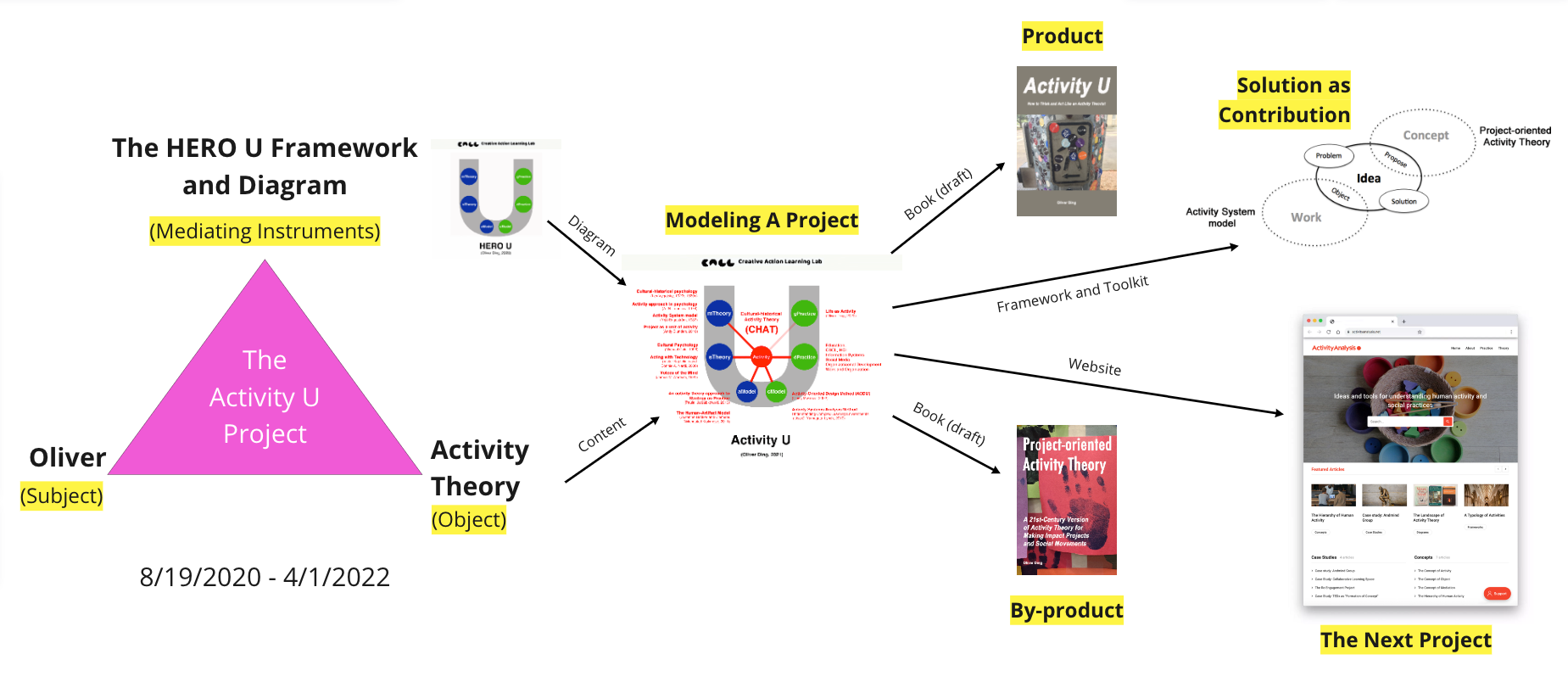
The above diagram uses "Model" and "Outcome" to expand the basic model of Activity Theory (Subject - Mediating Instruments - Object). You can pay attention to the yellow highlight:
- Subject
- Object
- Mediating Instruments
- Concept (the above case doesn't have it)
- Modeling A Project
- Product
- By-product
- Solution as Contribution
- The Next Project
- Service (the above case doesn't have it)
I used these Operational Concepts as keywords to analyze each project and made diagrams.
5. Operational Concepts and Theoretical Concepts
I made a distinction between Theoretical Concepts and Operational Concepts. You can find more details about a typology of concepts in Knowledge Discovery: The “Concepts — Notions” Mapping.
- Theoretical Concepts are the foundation of theoretical approaches such as Meta-theories and Specific Theories. They can be used to develop knowledge frameworks.
- Operational Concepts are developed for empirical research and reflection. It can be generated from theoretical concepts or not.
Some members of the above list are theoretical concepts. For example, "Subject", "Object", and "Mediating Instruments" are both theoretical concepts and operational concepts. If we use a theoretical concept as an operational concept, we can use different words to refer to the same theoretical concept. For example, "Mediating Tools", "Mediating Instruments", and "Mediation" refers to the same theoretical concept. For empirical research and reflection, these words can be used interchangeably.
However, "Modeling A Project", "Solution as Contribution", and "The Next Project" are Operational Concepts only. They are only useful for the method of "Mapping Thematic Journey".
The rest of the article will offer more details about these operational concepts. I will use one case as an example for explaining these keywords.
I also use Primary Operational Concepts and Secondary Operational Concepts for the method of "Mapping Developmental Project". While the yellow highlight refers to Primary Operational Concepts, small-size texts mean Secondary Operational Concepts.
I used the following Secondary Operational Concepts for the above four case studies:
- Concept
- New Concept
- Diagram
- Meta-diagram
- Domain
- Content
- Basic Principles
- Book (draft)
- Tool and Method
- Framework and Toolkit
- Framework
- Website
- Themes of Practice
- Knowledge Center
These terms are relevant to the Knowledge Engagement Journey. You can a similar taxonomy in the Knowledge Discovery Canvas.
6. The Developmental Project Model
Though the method of "Mapping Developmental Project" uses the above diagram, it only focuses on "Mediation", "Model", and "Outcome" of Developmental Projects.
If we want to explore more aspects of Developmental Projects, we can use the Developmental Project Model which is a sub-framework of the Project Engagement approach.
I started the Activity U project in August 2020. The diagram below uses the Developmental Project Model to reflect on my experience with the project.

The eight elements of Developmental Projects form three groups as a process of transformation.
- The first group is defined as Situational Context which highlights three important aspects of Developmental Projects: Purpose, Position, and Program.
- The second group is defined as Developmental Resources which highlights three types of potential opportunities for Developmental Projects: Social, Content, and Action.
- The third group is defined as Impact by Projects which considers personal development caused by joining Developmental Projects from two dimensions: Theme and Identity.
You can find more details in Developmental Project Canvas.
Initially, I just made a diagram called “Activity U” which is a test of the “HERO U” framework. I wrote a post to explain the diagram “Activity U”. The original title of the post is Activity U: The Landscape of Activity Theory. Later, I added “(Part I)” to the end of the title. It expanded from one post to a series of articles.
On October 1, I wrote a post to review the first year of CALL (Creative Action Learning Lab) and claimed that Activity Theory is a learning object for Transdisciplinary Thinking which means knowing between academic domains and non-academic domains. I pointed out four reasons for selecting Activity Theory for Transdisciplinary Thinking:
- It is an established theoretical tradition.
- It is an interdisciplinary philosophical framework for studying both individual and social aspects of human behavior.
- It has inspired many empirical studies in various domains.
- Its root is in cultural background and psychological research tradition outside North America.
The last reason is unique. In a general sense, the mainstream of North American psychology is dominated by individual perspectives. In contrast, the psychological root of Activity Theory is the social perspective. Thus, I want to bring a new perspective to the next generation of knowledge workers and boundary creators in North America.
7. Product, By-product, and Meta-product
Why did I define the middle circle as Mediating Instruments for Thematic Journey Map?
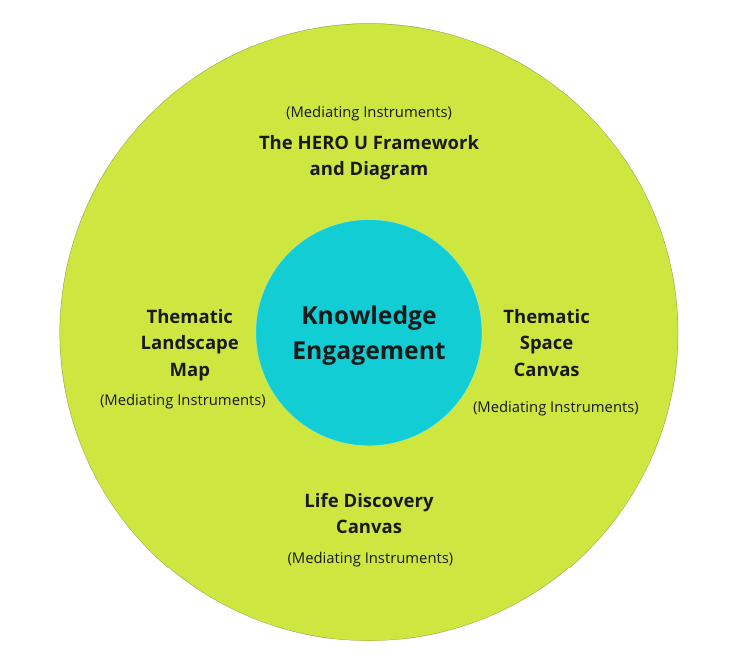
The Slow Cognition project is part of the Creative Work Study Enterprise which aims to research Knowledge Creators' work and life.
A significant difference between creators and others is that creators tend to use existing tools in creative ways or make new internal tools for their work and life. Eventually, they turn some internal tools into external products. For example, Slack began as an internal tool for Stewart Butterfield's company Tiny Speck during the development of Glitch, an online game.
Moreover, there is an important difference between knowledge creators and other types of creators: knowledge creators' products and their tools are homogenous. For example, I used a diagram called HERO U as a tool for the Activity U project. One product of the project is a set of diagrams about Project-oriented Activity Theory. Knowledge creators can use existing knowledge to produce new knowledge.
The method of Mapping Thematic Journey focuses on a knowledge creator's Creative Work, not Knowledge Centers. I selected Lev Vygotsky's "Mediating Action" model as the theoretical foundation of Mapping Thematic Journey. In this way, we can discover more patterns in the transformation between Mediations, Models, and Outcomes.
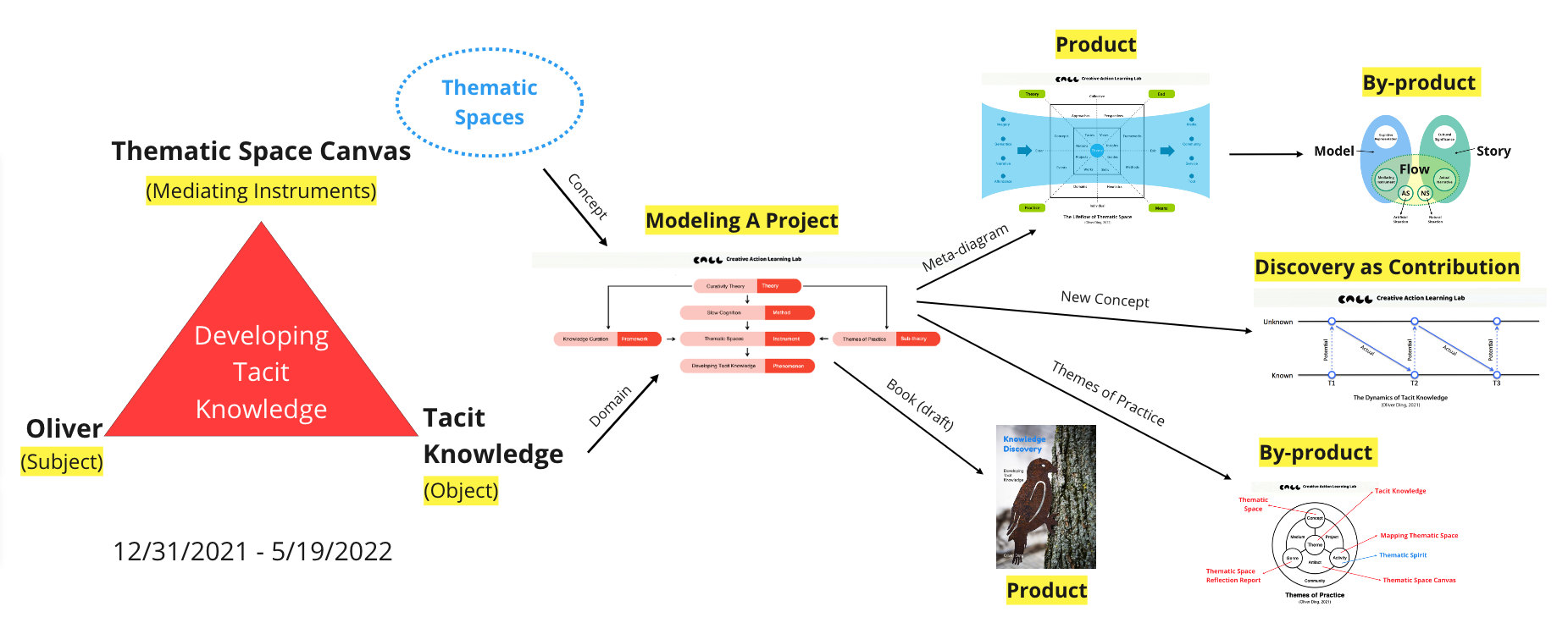
The "Mapping Developmental Project" method uses the following keywords to define Outcome:
- Product
- By-product
- Meta-product
I also use the following diagram to build a model of Outcome.

The Achievement Chain is inspired by the following theoretical resources:
- The Activity System Model (Yrjö Engeström,1987): Subject — Outcome.
- The evolving systems approach to the study of creative work (Howard E. Gruber, 1974,1989): By-product.
- The constructive — developmental approach (Robert Kegan, 1982, 2009): The Evolving Self.
The Product refers to the intended outcome within the original object of activity and the by-product refers to the unintended outcome beyond the original object of activity. The meta-product refers to the self. This notion means the transformation of self as the outcome of temporal activity chains.
Since the outcome of an activity can be a resource for a new activity, we can see the temporal activity chains as "Reproduction of Activity". This notion is very useful for understanding the pattern behind a Possible Journey because it doesn't have a plan for the path.
Moreover, the development of Creative Work is an interactive process of "Reproduction of Activity" and "Transformation of Self". We have to pay attention to the creative person's idea about "Self". Gruber emphasizes, "Each creative person has certain conceptions of his or her life tasks. Although we think of the creative person as highly task-oriented, rather than ego-oriented (Amabile, 1983), it is also true that the set of tasks taken as a whole constitute a large part of the ego: To be oneself one must do these things; to do these things one must be oneself."
I consider "Transformation of Self" as the Meta-product of activities.
By-product is a normal phenomenon for experienced individual workers and teams. In his study of Charles Darwin, Howard Gruber (1974) showed that even a great scientist embraces by-productive thinking in his creative work process.
Gruber said, “In his beautiful book Productive Thinking, Max Wertheimer, founder of Gestalt psychology, focused his attention on the kind of direct thinking that goes to the heart of the probiel under attack. In Darwin’s long and twisting path, however, there are several striking examples of important steps toward the theory of evolution through natural selection being taken as by-products of efforts that seemed to move in other directions…The theory of coral reefs was based on an extrapolation from what Darwin has learned about the formation of continental mountain chains; if mountains are up-raised, he reasoned, the adjacent sea bed must sink; from this slow subsidence of the sea bed, the coral-reef theory followed. That theory does not deal at all with organic evolution, but it does provide a formal model quite analogous to Darwin’s eventual theory. Darwin did not have a five-year plan to move through this important sequence of ideas. It evolved. The monad theory, itself short-lived in Darwin’s thought and not entirely original, led him to his branching model of evolution. This became a cornerstone of his thought.” (1974, p.112)
In contemporary knowledge work activities, there are many ways to generate by-products. You can find more details in Life-to-be-Owned: The Achievement Chain.
The above diagram uses the Thematic Space Canvas project as an example. The focus of the project is the process of Developing Tacit Knowledge. In order to understand the process, I developed three canvases that form a lifeflow of the process. See the diagram below.

The above diagram refers to the following three canvases:
- The Spark Space Canvas
- The Thematic Space Canvas
- The Statue Space Canvas
These canvases are Products of the project. You can find more details in Slow Cognition: Three Canvases for Developing Tacit Knowledge.
In order to understand the context of Developing Tacit Knowledge, I used the "Flow - Story - Model" metaphor to develop a model on Jan 11, 2022. See the diagram below.

The above diagram puts Thematic Space in the context of life development with a simple metaphor: Flow, Film, and Floor Plan.
- Experience > Flow > Life as a continuous flow
- Story > Film > Project as a film with a prominent theme
- Model > Floor Plan > Thematic space as a floor plan
You can find more details in Thematic Space: Flow, Film, and Floor Plan.
The "Flow - Story - Model" metaphor is a by-product of the project. Later, I turned the above diagram into the following model on March 15, 2022 for developing the model of the Curated Mind.

I also use "Contribution" as a keyword for the above two case studies. It should be part of the Outcome, however, there are more details about the notion of "Contribution". We need a new section for this topic.
8. Results, Rewards, and Contributions
Activity Theorists don't use "Results", "Rewards", and "Contributions" for theoretical approaches.
For the method of "Mapping Thematic Journey" and the Creative Work Study project in general, I consider "Results", "Rewards", and "Contributions" as Operational Concepts for empirical research and reflection because these ideas are related to both "Reproduction of Activity" and "Transformation of Self".
The concept of Result is inspired by the concept of Outcome from Activity Theory. The Reward is about human motivation.

I prefer to use the above diagram to understand the concept of Outcome in general and the concept of Result for the Anticipatory Activity System framework. You can find more details in Life Discovery: The “Result — Reward” Gap and Achievement.
For the concept of Reward, I’d like to adopt an established theory about human motivation: Self-Determination Theory (SDT) which pays attention to the Self and the Environment. It perfectly matches the Anticipatory Activity System framework because the Other is just an environment of the Self.
For the Anticipatory Activity System framework, the relationship of “Self — Other” involves internalization and integration through Reward.
However, there is a missing piece in Self-Determination Theory. Since SDT's OSI model focuses on the intrinsic — extrinsic continuum, it doesn’t consider the temporal distance between “Result” and “Reward”.
I’d like to call this temporal distance the Result — Reward gap. I use “Result” to refer to the First-order Outcome which means the final end of the transformation from “Object” to “Outcome”.
Now we can discuss the Second-order Outcome with a term: Reward. The logic is clear because Reward is based on Result. Also, I consider Punishment as Negative Reward in order to reduce the number of concepts for the Anticipatory Activity System framework.
- Positive Results lead to Positive Rewards
- Negative Results lead to Punishments (Negative Rewards)
Outcome (both Results and Rewards) could lead to a new activity. A new activity could be driven by a Result which is about the material change of an object. Or, a new activity could be driven by a Reward which is a mental activity about a Result.
Now we have a model that offers an explanation of the relationship between Outcome and Reproduction of Activity.
What about the notion of "Contribution"? It refers to the Evaluation of Results. For the Creative Work Study project, I adopt the creativity researcher Robert J. Sternberg's Propulsion Model of Creative Contributions (1999) as a tool for discussion.
According to Sternberg, a creative contribution is defined as something that is (1) relatively original and (2) high in quality with some purpose. Scholars and researchers have developed many approaches to classify different types of creative contributions.
In 1999, Sternberg developed the Propulsion Model of Creative Contributions and suggested seven types of contributions. In 2001, he expanded the original model to eight types. See the diagram below.
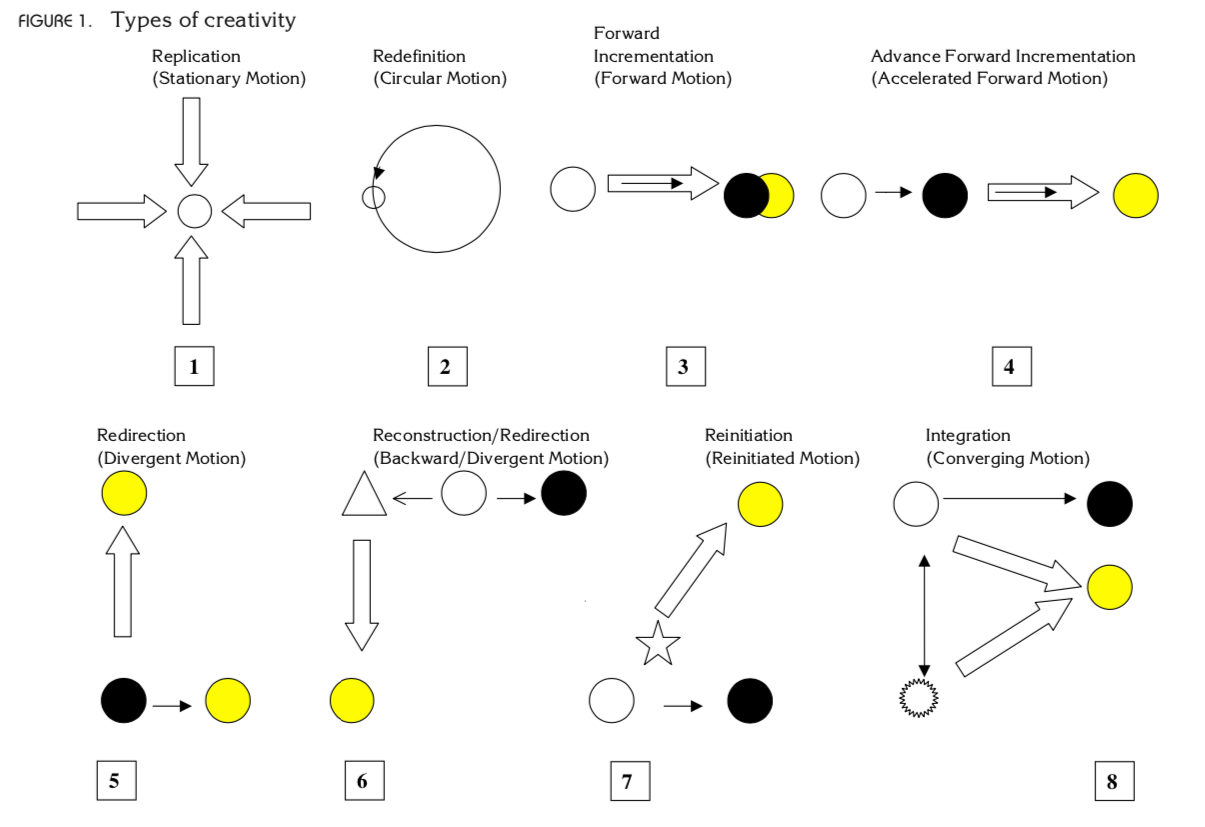
The eight types of creative contributions are:
- Replication
- Redefinition
- Forward Incrementation
- Advance Forward Incrementation
- Redirection
- Reconstruction/Redirection
- Reinitiation
This article doesn't use this model for case studies. But I consider it as a tool for the method of "Mapping Thematic Journey". We may use it for case studies in the future.
You can find more details in The Propulsion Model of Creative Contributions Applied to the Arts and Letters.
9. Modeling A Project
A critical component of the method of "Mapping Thematic Journey" is "Modeling A Project".
Why do we need a model for a project?
It's not necessary to have a model for every project. However, if a project involves a lot of information, a suitable model can help us reduce the pressure of information overload. Also, some models offer potential creative solutions for developing ideas.
In Feb 2022, I worked on the Life Discovery Canvas project. See the diagram below.
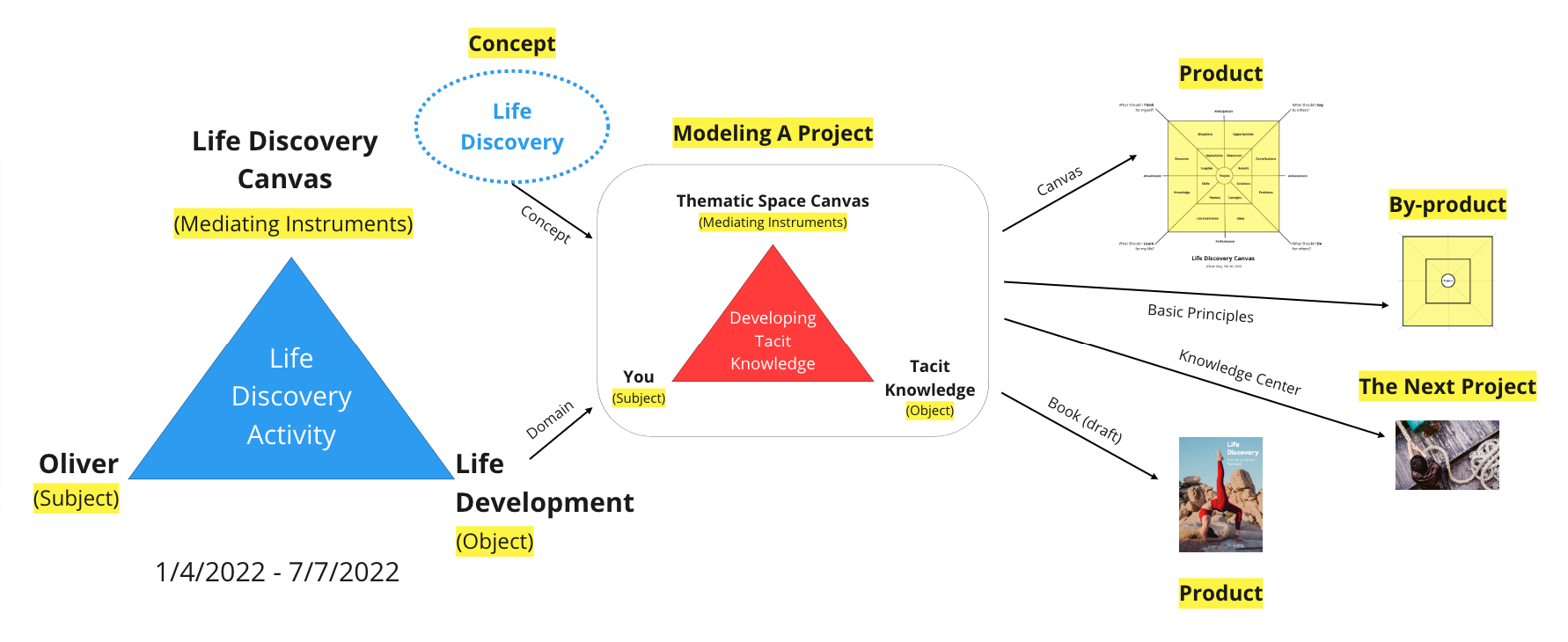
The “design thinking” behind the Life Discovery Canvas is pretty unique. It is both simple (for me) and complicated (for you).
For me, I just copy spatial structure from the Thematic Space Canvas for the Life Discovery Canvas because they share the same spatial structure. Thus, I don’t have to do the work of Visualization. What I need to do is replace old concepts with new concepts for understanding Life Discovery Activity.
The previous article The Life Discovery Canvas (v1.0) — Part 1: Theoretical Background introduced the theoretical background of the Life Discovery Activity. The major resource of the canvas is the Project-centered approach.
There is a deep analogy between the two projects, see the diagram below.

This deep analogy is based on the basic model of Activity Theory: Subject — Mediating Tool — Object. You can find more details on the Activity Analysis website.
I consider both “Developing Tacit Knowledge” and “Life Discovery” as Activities. From the perspective of Activity Theory, Thematic Space Canvas and Life Discovery Canvas are both Mediating Tools.
Moreover, what I found is that “Life Discovery” can be understood as a subcategory of “Developing Tacit Knowledge” if we consider the target of knowing as a person’s own life development. The process of discovering new insights for life development is a process of Developing Tacit Knowledge.
Can we directly apply the Thematic Space Canvas to Life Discovery Activity?

The above is the Thematic Space Canvas which is developed for Developing Tacit Knowledge. We can. However, we should translate the above concepts into some new concepts which are more relevant to Life Discovery Activity.
I can replace all the old concepts with new concepts without designing the visual-spatial structure.
As mentioned above, there is a deep analogy between the Thematic Space Canvas and the Life Discovery Canvas. See the picture below:

The red words refer to Thematic Space Canvas while the blue words refer to Life Discovery Canvas. I have to point out that Life Discovery Canvas is not a direct application of Thematic Space Canvas. They just share the same spatial structure.
We don’t have to check the one-to-one mapping relationship between concepts from two canvases. From the landscape view, these concepts share the same spatial configuration.
You can find more details about this case in The Life Discovery Canvas (v1.0) — Part 2: Spatial Structure.
Now, let's move from case study to general discussion.
In March 2022, I developed a framework called "Modeling A Developmental Project". See the diagram below.

"Modeling A Developmental Project" is one of the challenges of Running a Developmental Project. It refers to how a person thinks about a developmental project and builds a model for the project. In the process of running the project, how does she or he change thoughts and modify the model?
A model can be described with text only. Diagrams or other visual things are not necessary for modeling a project. However, if a person can use visual skills to express her or his mind, it would be great for discussing with others.
The process of modeling a developmental project can be understood as a process of developing tacit knowledge about the project.
There are two types of cognitive operations for modeling a developmental project:
- Conceptualization: How do you think about the project?
- Visualization: How do you draw your thoughts?
However, the Visualization operation is not necessary. It all depends on a person’s skills.
I have written several articles about designing knowledge diagrams and knowledge canvases. In an article about knowledge canvases, I suggested a foundational principle for designing canvas:
A good canvas matches visual areas and conceptual spaces with a simple and unique style of spatial configuration.
The principle leads to the following rules:
- Rule 1: Separate several visual areas clearly with lines. Make sure each visual area is identified easily.
- Rule 2: Adopt a special and unique perspective to develop conceptualized knowledge for building conceptual spaces. The more unique the perspective, the greater the value of the canvas.
- Rule 3: Make sure the layout of visual areas matches the structure of conceptual spaces. Take the visualization radically.
- Rule 4: Develop a simple and unique visual style that represents a spatial configuration. The uniqueness is the starting point of a knowledge brand.
I also designed a series of meta-diagrams that can be used for modeling a developmental project.
Each project has its own challenges and situations. A person could adopt knowledge from different sources to build a model or modify a model. I roughly consider three types of sources of knowledge:
- Self: the person’s own ideas, experiences, creations, etc.
- Other: a person’s friends or contacts offer some relevant knowledge resources.
- Public: a person can search for relevant knowledge in public spaces such as the internet or libraries.

A model can appear in different spaces. I consider the following three spaces:
- Mind: a person thinks about a project and has a rough idea bout it. However, she can’t express it. Or she doesn’t want to express it.
- Private: the person expresses a model of a project in text, voice, or diagram. But she doesn’t share it with others.
- Shared: the person shared the model with others through some communicative channels.

You can find more details in CALL for LIFE: Modeling A Developmental Project.
10. Developing A Concept
I also use "Concept" for the method of "Mapping Thematic Journey". This idea is adopted from Project-oriented Activity Theory.
A major development of Activity Theory during the past decade is Andy Blunden’s account “An Interdisciplinary Theory of Activity”. In order to develop the notion of “Project as a unit of Activity” as a theoretical foundation of the new interdisciplinary theory of Activity, Blunden adopts Hegel’s logic and Vygotsky’s theory about “Unit of Analysis” and “Concept” as theoretical resources. The process is documented in four books: An Interdisciplinary Theory of Activity (2010), Concepts: A Critical Approach (2012), Collaborative Projects: An Interdisciplinary Study (2014), and Hegel for Social Movements (2019).

In the 2012 book Concepts: A Critical Approach, Blunden reviews the theoretical development of Concepts in an interdisciplinary approach which curates theories about Concepts from various disciplines such as cognitive psychology, analytic philosophy, linguistics, and the history of science. He adopts Hegel’s theory of concept and Lev Vygotsky’s cultural-historical psychology as theoretical resources and proposes a new approach to Concepts. He argues that concepts are equally subjective and objective: units both of consciousness and of the cultural formation of which one’s consciousness is part. In other words, the formation of a concept is activity.
The notion of "Formation of Concepts as Activity" is a significant insight of Andy Blunden's approach to Activity Theory. Following this notion, I consider "Concepts" as both a theoretical concept and an operational concept for Mapping Themtaic Journey.
For example, the Knowledge Center Project is a project of formation of "Knowledge Center". See the diagram below.
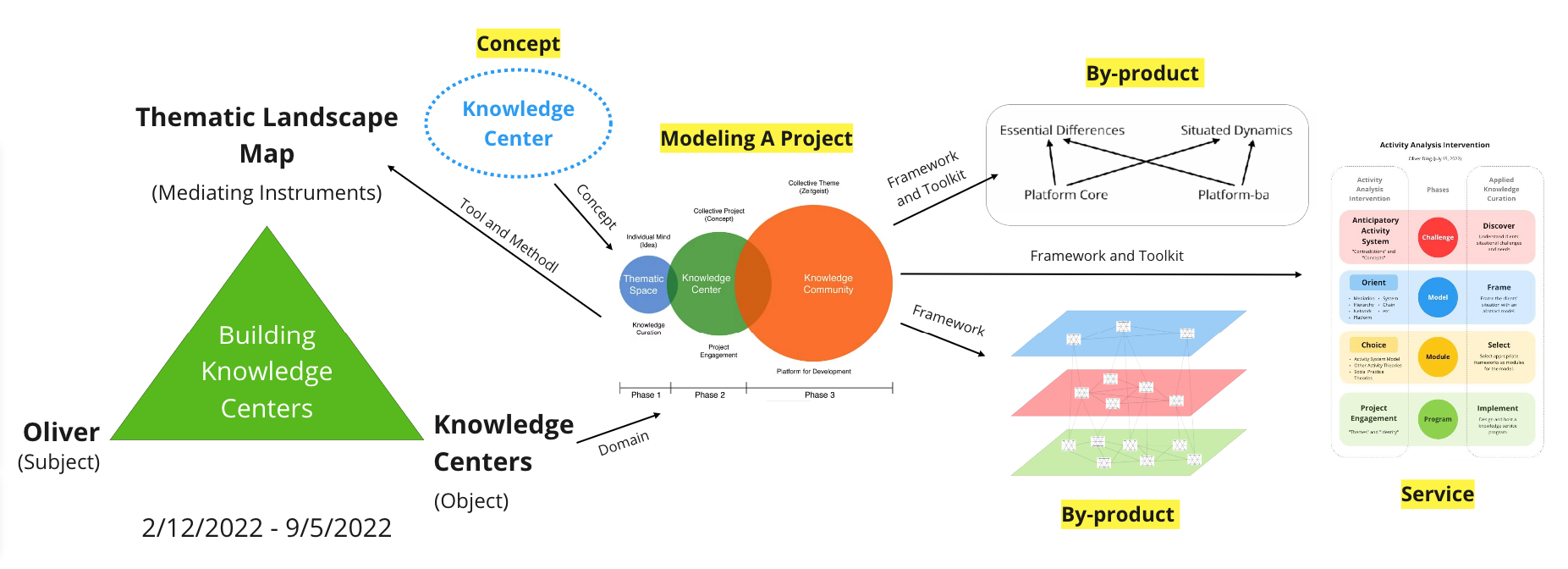
The concept of “Knowledge Center” was born from a talk about Activity Theory and the Activity Analysis project. On Jan 2, 2022, I had a 71-minute talk with a friend of mine. I briefly introduced the development of my personal studio CALL in the past year.
At the end of the talk, we chatted about the future of CALL in 2022. I mentioned the Activity Analysis project. I told him that I’d like to run it as a Knowledge Center.
The notion of Knowledge Center was a new spark for me. I didn’t use the term to describe the Activity Analysis project before the talk. As a new spark, it emerged from a conversation.
On Jan 13, I designed the diagram below to visualize what I talked about the notion of Knowledge Center with my friend on Jan 2.
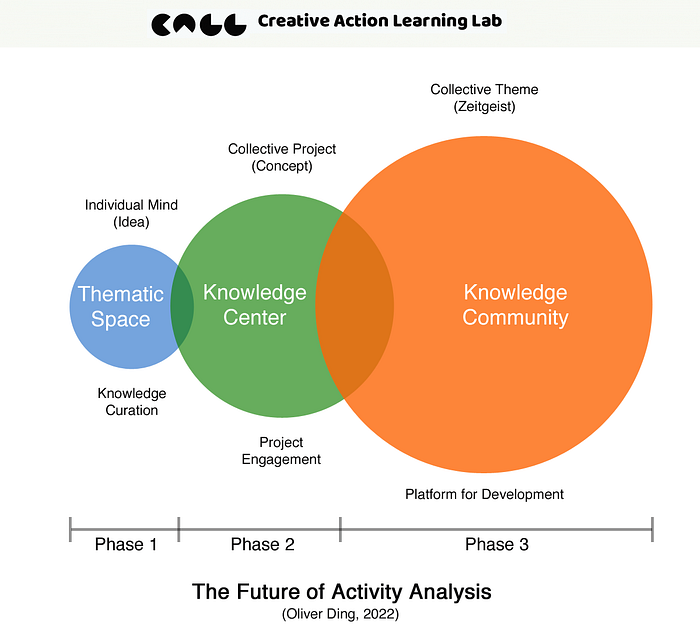
The above diagram describes an imagined project with a new concept.
- An imagined project: the Activity Analysis project
- A new concept: Knowledge Center
Now, the Activity Analysis project is a website that refers to my “Activity” thematic space. The website is just about an idea that belongs to an individual mind.
In the next phase, the Activity Analysis project is expected to grow as a knowledge center as a collective project. That means it is not my personal idea, but it should be a concept shared by a group of people who are passionate about adopting the “Activity” thematic space for their epistemic development. Also, they would like to contribute to the development of the collective “Activity” thematic space.
Phase 3 is building a Knowledge Community. The difference between Knowledge Center and Knowledge Community is Scope and Scale. A knowledge center may only have less than 15 members while a knowledge community may have thousands of members.
The three-phase development is inspired by Project-oriented Activity Theory.

I used the above diagram to explain the concept of “culture” from the perspective of Project-oriented Activity Theory. It zooms out to a large view that connects the Individual mind (Idea) and Collective theme (Zeitgeist) through Collective Projects (Concept).
The above diagram also mentions three knowledge frameworks I am working on:
Each knowledge framework could be adopted to support one phase of the Activity Analysis project.
- The Knowledge Curation framework is for the development of “Activity” thematic space (phase 1).
- The Project Engagement framework is for the development of “Activity” knowledge center (phase 2).
- The Platform for Development framework is for the development of “Activity” knowledge community (phase 3).
From the perspective of Project-oriented Activity Theory, there is a new Concept called Knowledge Center behind the Activity Analysis project. It means that the Activity Analysis project is the demo of the concept of “Knowledge Center”.
Later, the Knowledge Center Project inspired me to develop the Platform Genidentity framework as a by-product. See the diagram below.

You can find more details in Mapping Thematic Space #4: The “Center” Thematic Space and Platform Genidentity: The Movements of Unfolding Uniqueness.
The Knowledge Center Project also led to the other by-product: the "Project Network" model.

The Model of “Project Network” is for discussing the idea of “Knowledge Center”. It’s a multiple-level network, not a one-level network.
- A Network of Themes
- A Network of Knowledge Centers
- A Network of People
Each level refers to one type of Project. The “Themes” level refers to “Concept as Project”. For example, “TEDx” and “Startup Weekend” are Concepts, and the global TEDx community is a large project. The global Startup Weekend community is a large project too.
The “Knowledge Centers” level refers to “Center as Project”. For example, Each local TEDx program and each local Startup Weekend chapter are local projects.
The “People” level refers to “Engagement as Project”. For example, if a person joins a local TEDx team as a volunteer, she can consider her own experiences and actions of participating in the team as a Developmental Project for her.
These three types of Projects are also embedded in three types of networks: a network of themes, a network of centers, and a network of people.
Later, the "Project Network" model inspired the notion of "Moving between Thematic spaces". Finally, these new ideas encouraged me to work on the new version of the Project Engagement approach. On July 30, 2022, I finished a 116-page thesis about v2.1 of the approach. You can find more details in Project Engagement (v2.1) as an Innovation Approach.
11. Developing A Service
The above case study also uses an operational concept called "Service". This section offers more details about it.
On Feb 10, 2022, I published Thematic Space: The Connected Hub and “Service Thinking” and started a new project that aims to connect Activity Theory and other theories with Service. See the diagram below.

The above diagram represents the process of connection. My first spark is SET which stands for “Structured Engagement Theory”. To be honest, it is just a framework, not a theory. However, I want to keep the name “SET” because it points out the core of the framework. In order to keep the name “SET”, I have to keep the word “Theory”. Anyway, let’s call it SET or the SET framework.
In 2019, I started adopting some theories to reflect on my experience and thoughts about “Social (Digital) Design” which refers to digital products for interpersonal communications. Eventually, I developed the SET framework and used it for my own projects later.
The notion of “Developmental Service” is a new idea. I just made it in Feb 2022. It refers to a special type of service such as educational services, summer camps, adult life development programs, life discovery activities, etc. This notion refers to my own perspective of individual development. It also echoes the concept of “Developmental Platform” and the “Developmental Project Model”.
On June 4, 2022, I also wrote an article titled Concept Dynamics: An Ontological Discussion about “Service”.
In July 2022, I developed the Knowledge Engagement Program (v1) for a client. Though the program focuses on “Service Knowledge Management”, it can be considered as a general program for applying the Project Engagement approach to Knowledge Management.
The program used the Anticipatory Activity System framework to develop the model. See the diagram below.

I adopt the “Anticipatory Activity System (AAS)” framework to understand “Service Knowledge Management”:
- First-order Activity: Software Product Development
- Second-order Activity: Service Knowledge Management
Why do we need to use the AAS framework? If we don’t understand the first-order activity, then we can’t understand the second-order activity. You can find more details in The AAS framework for Life Strategy and Service Knowledge Management.
Later, I realized that I can apply the same framework to "Knowledge Center".
- First-order Activity: Knowledge Service
- Second-order Activity: Knowledge Discovery
See the diagram below.
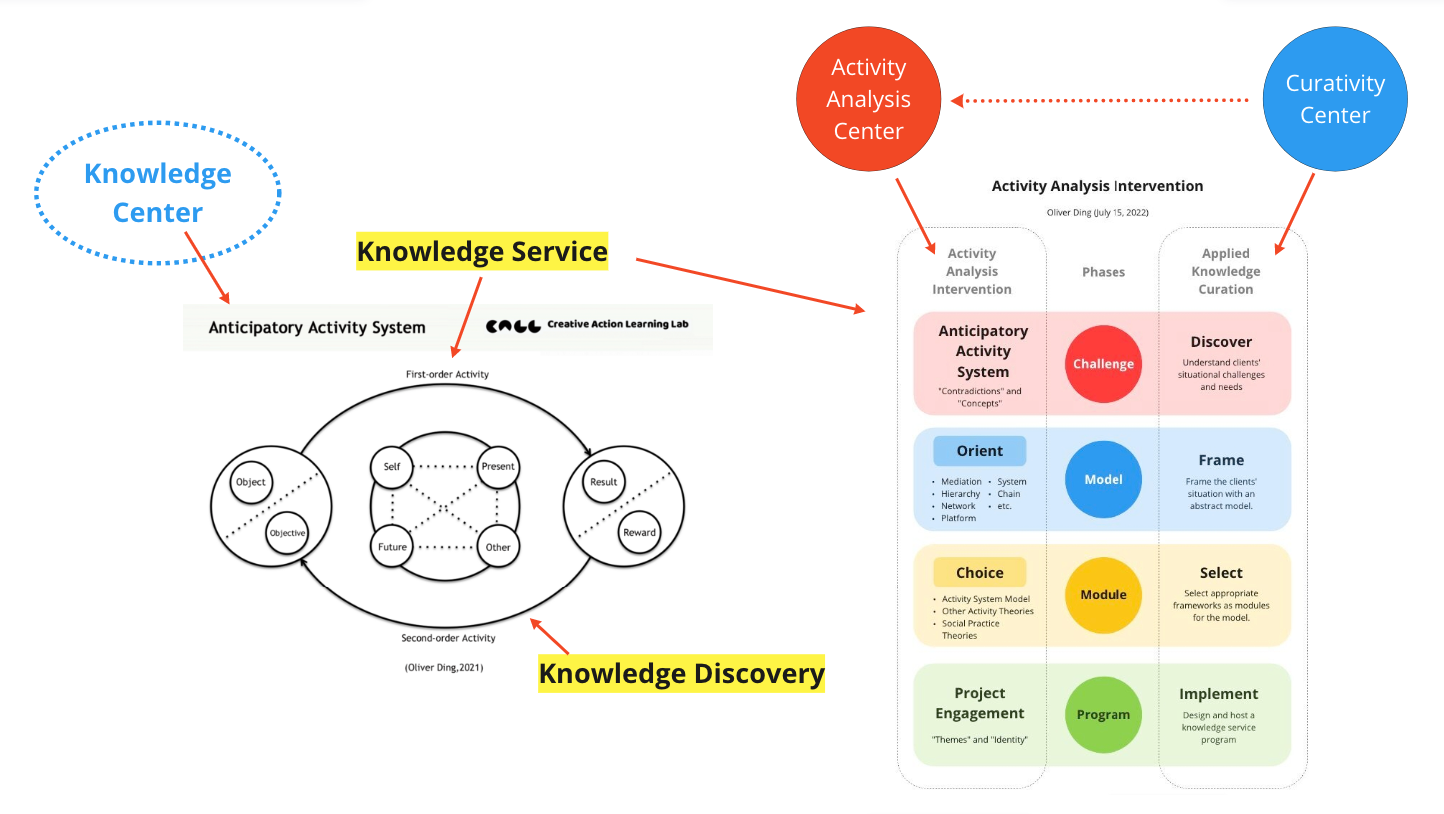
The above diagram also mentions the "Activity Analysis Intervention" program and two knowledge centers:
- Curativity Center
- Activity Analysis Center
What's the relationship between Curativity Center and Activity Analysis Center?
As a meta-center, Curativity Center offers curation-related knowledge services to Activity Analysis Center. For example, it offers the "Applied Knowledge Curation" framework and helps Activity Analysis Center to develop its own knowledge service: the Activity Analysis Intervention program.
Activity Analysis Center works on two things: 1) knowledge curation, which is about curating various theoretical approaches to Activity Theory and social practice theories, and 2) knowledge creation, which refers to my own theoretical models and frameworks about human activity and social practices.
For Activity Analysis Center, the Activity Analysis Intervention program is a Knowledge Curation service.
The Activity Analysis Intervention program aims to offer a Theory-based Reflection solution for practitioners. It doesn't want to directly solve problems for practitioners but offers a new way to improve mindset by adopting theoretical perspectives.
I roughly consider the following four steps for Activity Analysis Intervention:
- Challenge
- Model
- Module
- Program
I will use my journey of "Engaging with Activity Theory" as an example.
Challenge
This step is about Discovery. It aims to understand clients' situational challenges and needs.
For the journey of "Engaging with Activity Theory", my situational challenge is reflecting on my three years of journey about Activity Theory. I need both theoretical frameworks or concepts and methods to help me understand four major projects as a meaningful whole.
Clients' challenges can be self-reflection, team change, or the transformation of social systems. My challenge is self-reflection.
Model
This step is about Orientation. It aims to frame clients' situations with an abstract model. This step is pretty unique because the method doesn't want to directly solve concrete problems.
The abstract model can be a rough perspective or dimension such as "hierarchy", "network", "mediation", "platform","development", "transformation", "contradiction", etc.
For example, Clay Spinuzzi selected the "Network" perspective for his project "Theorizing Knowledge Work in Telecommunications".
In ordr to curate four projects as a meaningful whole, I used "Journey" and "Project" as metaphors to build the basic model.
Though "Journey" is not a theoretical concept of Activity Theory, I can use it as a metaphor for Orientation which only needs a rough connection.
Module
The third step is about Selection. It is about selecting appropriate frameworks as modules for the model. The field of Activity Theory and Social Practice theories has many theoretical approaches and frameworks. We can choose some frameworks and curate them together as a practical toolkit.
For example, Clay Spinuzzi selected "Activity Network" and "Actor-network Theory (ANT)" for his project.
There are three significant aspects of my journey of "Engaging with Activity Theory": Themes, Instruments, and Individuals. Activity Theory is a large knowledge enterprise, its primary theme is "Activity". I also noticed that I made several tools for the journey. Finally, my journey is an independent exploration. Thus, I considered "Instruments" as the primary dimension and selected Lev Vygotsky's "Mediating Action" as the primary model because it is about individual actions.
I also selected several ideas from other approaches for Primary Operational Concepts and Secondary Operational Concepts.
Each operational concept can refer to a related model or framework. Since these frameworks are part of my tacit knowledge, I can use them easily.
For other people, it may take time to learn these related models. Or, we can let them select frameworks for operational concepts.
Program
The final step is about Implement. It means designing and hosting an intervention program with the practical toolkit which is the outcome of the above steps.
My case is for self-reflection, so the implement is very simple. I just need to collect facts about the four projects and put them on the Thematic Journey Map. I also conducted "Mapping Developmental Project" for each project.
If we apply the "Activity Analysis Intervention" program to team change and the transformation of social systems, then the Implement step could be complicated.
As mentioned above, the Activity Analysis Intervention program aims to offer a Theory-based Reflection solution for practitioners. The Implement step should be run by practitioners because they need to directly solve problems in their own situations.
12. An Expansive Model
The Thematic Journey Map uses the basic model of Activity Theory: Lev Vygotsky's "Mediating Actions". It also echoes two basic principles of Activity Theory: Tool mediation and Development.
In 2012, Kaptelinin and Nardi summarized five basic principles of Leontiev’s activity theory:
- Object-orientedness
- Hierarchical structure of activity
- Mediation
- Internalization and externalization
- Development
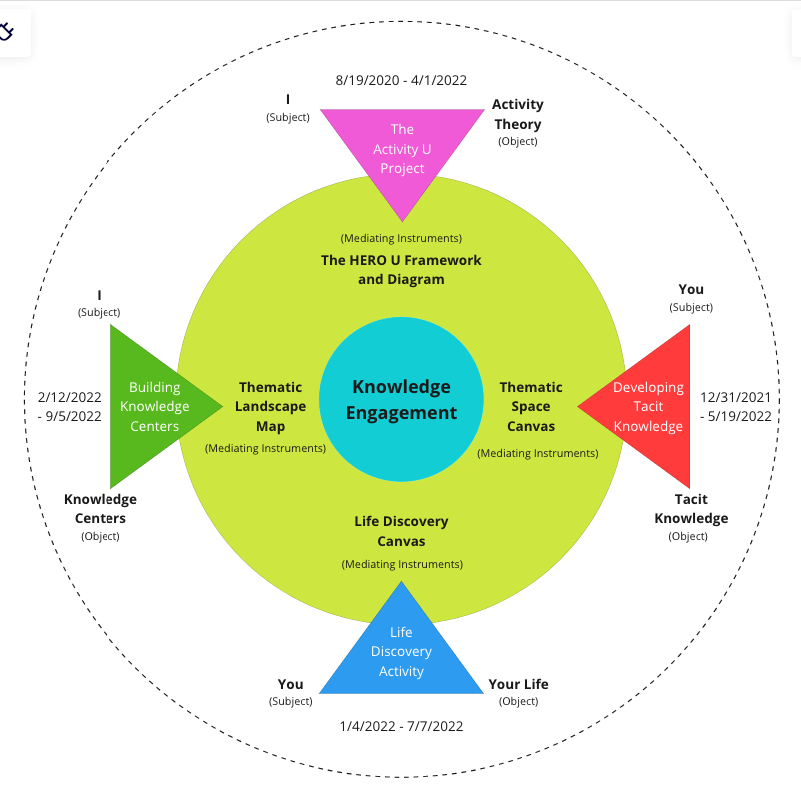
Some Activity Theorists also use the term "Instruments" to replace the term "Tools" or "Mediating Tool".
As Kaptelinin and Nardi explained, "Tool mediation allows for appropriating socially developed forms of acting in the world. Tools reflect the previous experience of other people accumulated in the structural properties of tools, such as their shape or material, as well as in the knowledge of how the tool should be used. Tools not only shape the external behavior; as discussed below, through internalization, they also influence the mental functioning of individuals. For instance, a person's cognitive map of a city may depend on whether or not the person is a car driver. A software developer understands the abstraction of layers of a software architecture. This understanding is actionable, and he or she does not need to be looking at a diagram of an architecture to use the knowledge in a design task." (p.31, 2012)
We should notice that what Kaptelinin and Nardi talked about is Existing Tools from the cultural context. However, we should notice that a member of a cultural group could make Emergent Tools for his own purpose in order to cope with challenges in his life world.
For the individual level of analysis, we should pay attention to both Existing Tools and Emergent Tools because the former refers to internalization and the latter refers to externalization.
As mentioned above, the above diagram is the basic model of Thematic Journey Map. If we expand the basic model of Activity Theory, the "Subject - Mediation - Object" model, to the Activity System Model, we can have an expansive model of Thematic Journey Map.
The diagram below is the Activity System Model which was developed by Yrjö Engeström in his 1987 book Learning by Expanding.
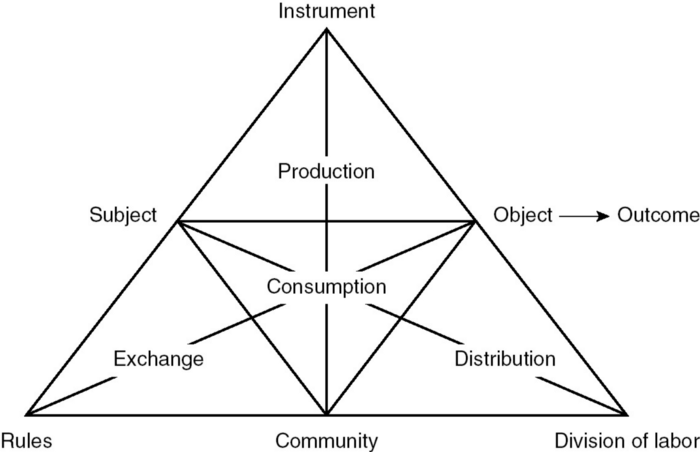
The above Engeström’s triangle is based on the cultural-historical psychologists’ notions of mediation as individual action (subject — instruments — object) at the top of the diagram.
Engeström (1987) considered “a human activity system always contains the subsystems of production, distribution, exchange, and consumption.”(p.67), thus, he added the bottom of the triangle to the original individual triangle in order to include other people (community), social rules (rules), and the division of labor between the subject and others.

According to Kaptelinin and Nardi, "The model is a result of a two-step extension of Leontiev's original concept of activity - that is, activity understood as 'subject - object' interaction - to the case of collective activity...Second, it was suggested that each of the three particular interactions within the structure is mediated by a special type of means. Concrete mediational means for these interactions, according to Engeström, are: (a) tools/instruments for the subject-object interaction (as also posited by Leontiev), (b) rules for the subject-community interaction, and (c) division of labor for the community - object interaction." (p.33-34, 2012)
Now we can build the expansive model of Thematic Journey Map. See the diagram below.
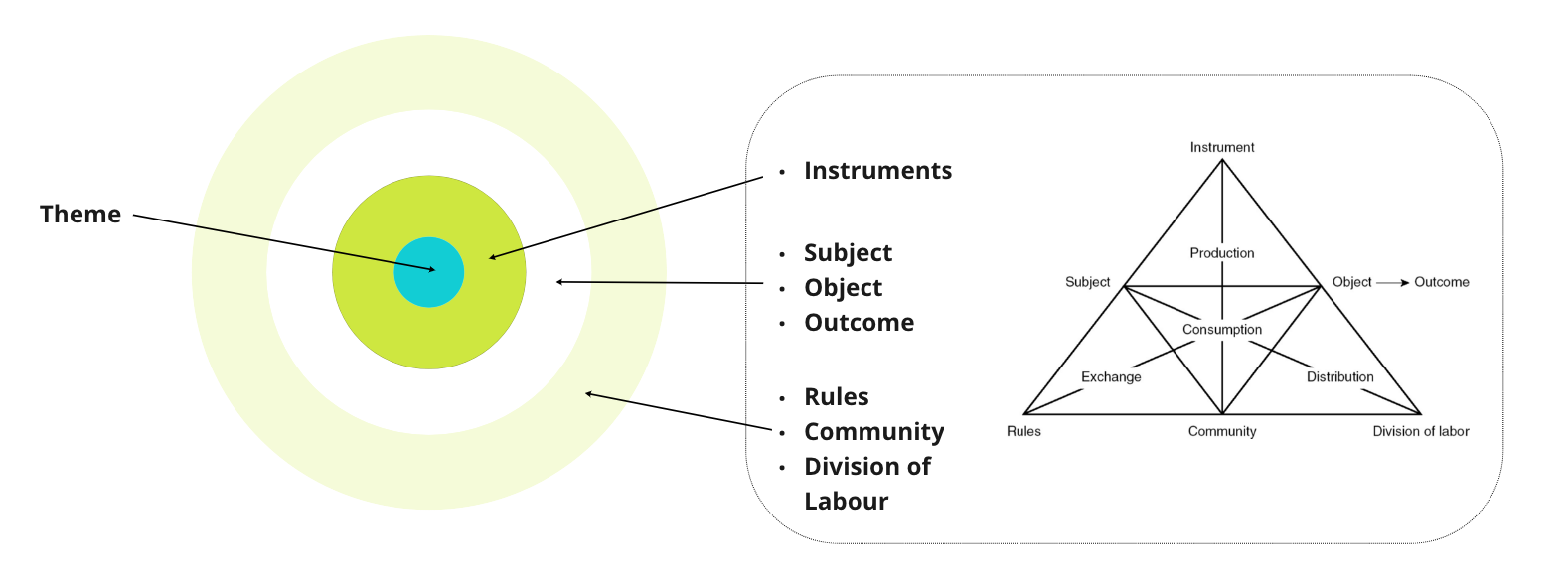
The new model uses four nested circles while the basic model uses three nested circles.
The diagram below is the Expansive version of Thematic Journey Map. since my case is more about individual actions, I use light colors for other parts.
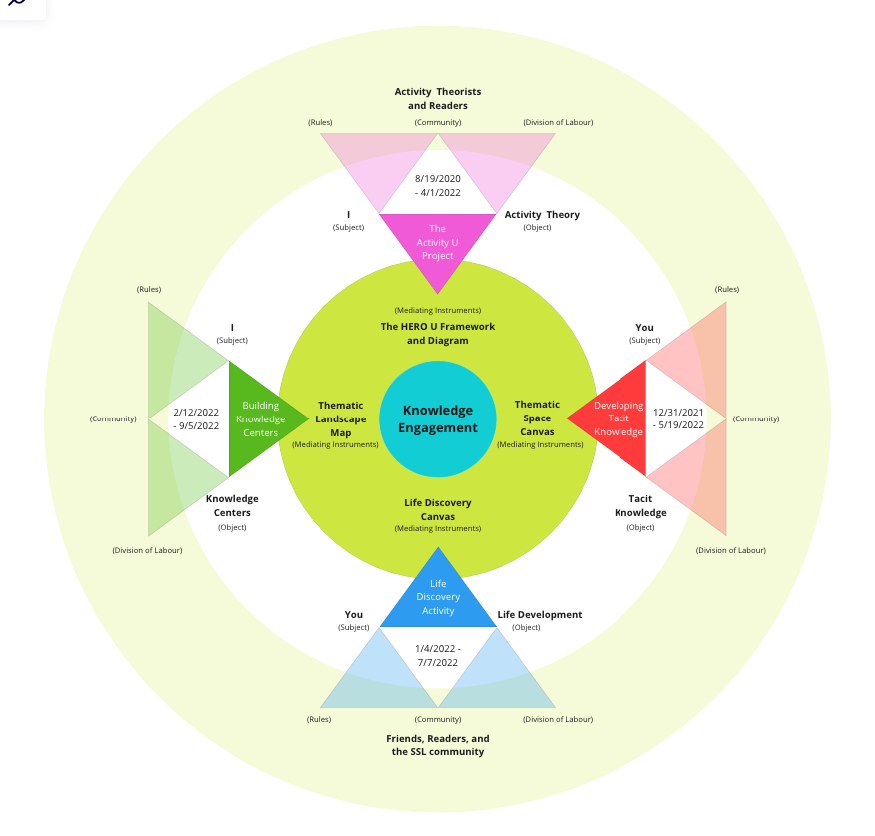
The Activity System model has an operational concept called "Outcome". I don't display it on the map. However, we can put data about "subject", "object", and "outcome" on the white circle.
The peripheral circle is used to display data about Rules, Community, and Division of Labour. See the diagram below.
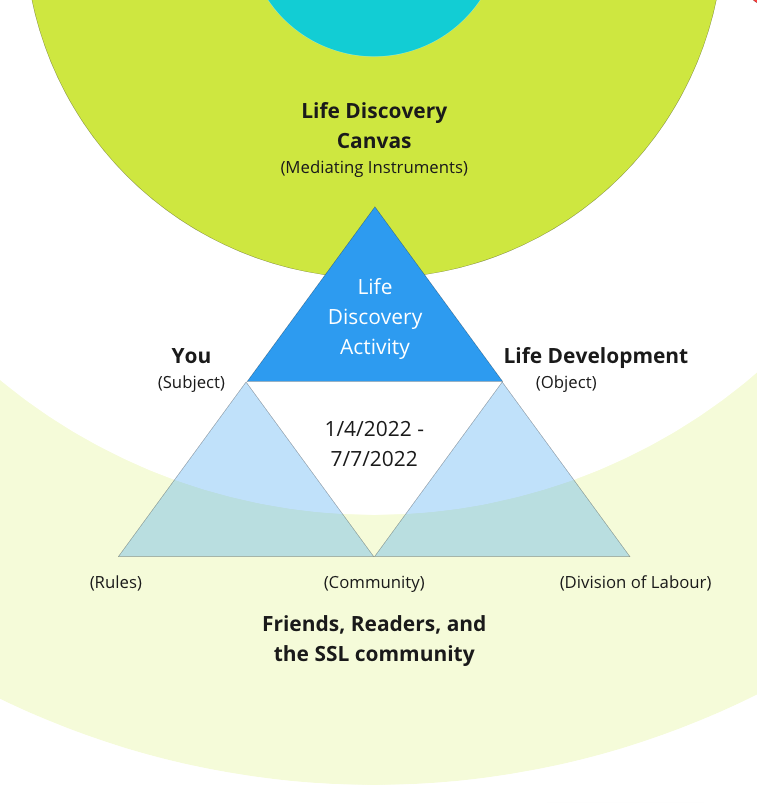
In fact, the "Life Discovery Activity" Project is a complicated project. From Jan 2022 to June 2022, I applied the Life-as-Project approach to Life Discovery Activity and developed a series of tools such as a toolkit, a canvas, and several models and frameworks.
You can find more details in Life Discovery: Biography, Journey, Program (and a possible book, Part 1) and Part 2, Part 3.
I also joined the following three Life Discovery Projects:
- Shaper & Supporter Lab (SSL): I am a researcher.
- The AAS Board: I am a coach and a service designer.
- The Slow Cognition Project (Phase I): I am a creator.
For the present discussion, I'd like to offer more details about the "Community". Let's use the SSL community as an example.
Shaper & Supporter Lab (SSL) was founded by a friend of mine in April 2021. The program was designed with three components: 1) Life Purpose Awareness, 2) Personal OKR Practice, and 3) Peer Review and Feedback. I joined the SSL program as an advisor and a researcher.
I use the Project Engagement approach to guide my research about the program. The approach uses a method called “Multiple-level Project Engagement”. I reflect on the following levels:
- The “My friend — Members” Engagement
- The “Member — Member” Engagement
- The “I — My friend” Engagement
The SSL program is a Life Discovery Project because it guides members to discover their life purposes, make life plans, and take real actions.
13. Knowledge Engagement: The Objectification of Concepts
Finally, we can move to the center of Thematic Journey Map: The primary theme of a Thematic Journey.
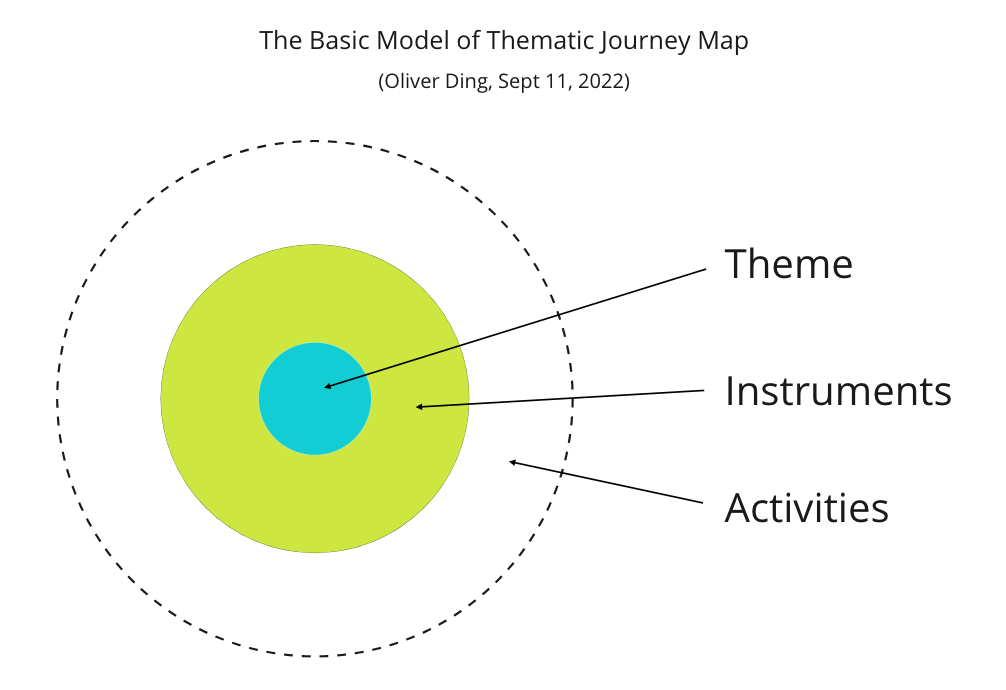
As mentioned above, I used "Knowledge Engagement" as the primary theme of my journey of "Engaging with Activity Theory".
What does the theme "Knowledge Engagement" mean?
The term "Knowledge Engagement" is inspired by the Project Engagement approach (v2.1). If you work on a knowledge-related project, you can use the term to describe your project.
As mentioned above, I use "Knowledge Engagement" to refer to the perspective of the Project Engagement approach (v2.1). Any knowledge-related project can be understood from the perspective.
However, this statement is too general.
What we can learn about "Knowledge Engagement" from my journey of Engaging with Activity Theory?
From the perspective of Project-oriented Activity Theory, a significant aspect of any knowledge-related project is the Objectification of concepts. See the diagram below.

The above diagram represents three types of objectification of a concept:
- Symbolic Objectification: “Verbal” and “Visual”
- Instrumental Objectification: “designed” and “found”
- Practical Objectification: “Branded” and “Shared”
For example, one core concept of the Ecological Practice Approach is Curativity which was coined in my 2019 book Curativity: The Ecological Approach to General Curation Practice. The picture below is the cover of the book. It’s a Symbolic Objectification of the concept of Curativity.

In the past three years, I applied Curativity Theory to the Knowledge Curation project and developed a series of tools such as the HERO U framework, the model of Knowledge Curation and its canvas, the Knowledge Discovery Canvas, etc.

The above picture is the Knowledge Curation Canvas which uses six columns to display six types of Objects for Curating. The content of the canvas is adopted from the Diagramming as Practice framework. You can find more details here.
This is an example of Instrumental objectification of the concept of “Knowledge Curation” which is an application of “Curativity”.
Another example of Instrumental objectification is the Thematic Space Canvas which is designed for “the Objective — Subjective Knowledge Curation”.
Five months ago, I did several things with the Thematic Space Canvas. For example, I run the first Thematic Spirit with a friend on March 19, 2022. The diagram below represents the landscape of my practice around the theme of “Tacit Knowledge” and the concept of “Thematic space”. These two ideas are related to “the Objective — Subjective Knowledge Curation”.

This is an example of Practical objectification of the concept of Knowledge Curation and the concept of Thematic Spaces.
The above secondary operational concepts point out many types of outcomes of objectification of a concept. See the diagram below.
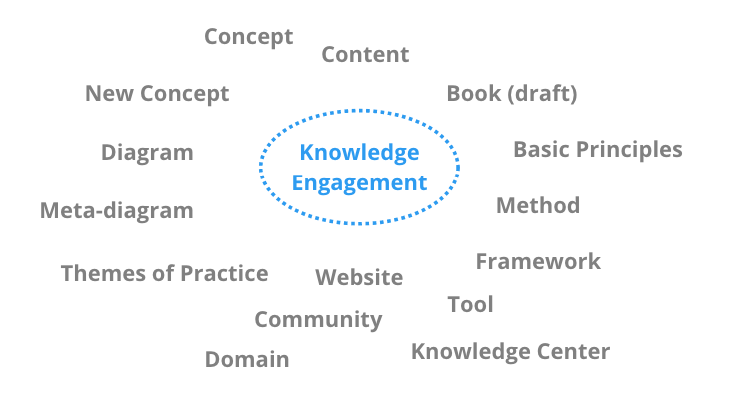
Knowledge Engagement is not only about thinking, but also about making and doing things about knowledge.
Knowledge is water, you can't grasp it.
You need a container to contain knowledge.
The above operational concepts are different types of knowledge containers.
My journey of Engaging with Activity Theory started with knowledge curation and moved to knowledge creation. It started with developing my tacit knowledge about Activity Theory and moved to develop a knowledge center about the "Activity" theme for others.
While we can use "Knowledge Engagement" for knowledge-related Projects, each knowledge worker has his/her own Journey of knowledge engagement because people curate their Creative Life in different ways.
14. Conclusion
The method of Mapping Thematic Journey is a new approach to visualizing multi-project journeys from the perspective of Activity Theory.
The sub-method "Mapping Developmental Project" links to several frameworks and models. We can see them as a toolkit for Mapping Thematic Journey.
The above discussion only selects four significant projects from my journey of "Engaging with Activity Theory" as examples. This article focuses on introducing the method, I don't go deep with each project.
In fact, my journey of "Engaging with Activity Theory" is very complicated. You can find more details about the Activity U project in the following board on Milanote.
You can also find a case study based on my experience of Developing Tacit Knowledge about Activity Theory in the following link.
In July 2022, I edited a possible book about the Life Discovery Activity project. You can find more details in Life Discovery: Biography, Journey, Program (and a possible book, Part 1, Part 2, and Part 3).

If you want to know more about the historical development of the Activity Analysis Center, you can read the following articles:
- Thematic Space: The Art of Continuous Discovery (Jan 17, 2022)
- Mapping Thematic Space #4: The “Center” Thematic Space (Feb 12, 2022)
- CALL: The Launch Day of Curativity Center (June 2, 2022)
- Activity Analysis Center: Curativity, Creativity, and Activity (August 5, 2022)
Finally, I'd like to claim that Mapping Thematic Journey and Knowledge Engagement are two new members of the Project Engagement approach (v2.1).

